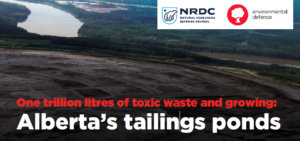 Tailings, the waste left behind from mining, remain on landscapes forever and sometimes their dams or casings fail, spilling toxins into waterways. A new report by the Environmental Defence and the U.S.’s Natural Resources Defense Council points to the toxic legacy of tailings generated from the tar sands industry in Alberta.
Tailings, the waste left behind from mining, remain on landscapes forever and sometimes their dams or casings fail, spilling toxins into waterways. A new report by the Environmental Defence and the U.S.’s Natural Resources Defense Council points to the toxic legacy of tailings generated from the tar sands industry in Alberta.
The report has lessons for New Brunswick, where the Sisson project, a large-scale open-pit tungsten and molybdenum mining operation and tailings pond, was given conditional federal government approval on June 23.
Tailings: enormous and toxic
For more than 50 years, Alberta’s tar sands industry has stored its tailings in huge lakes or tailings ponds. The industry prefers to call these sites, “tailings storage facilities.”
According to the report, “Report: Alberta’s Tailings Ponds: One Trillion Litres of Toxic Waste and Growing,” tailings from Alberta’s tar sands now amount to 1.18 trillion litres.
What does 1 trillion litres even look like? The report says, “If Michael Phelps decided he needed a freshly filled Olympic-sized swimming pool to train in every day, it would take him over a thousand years to use 1 trillion litres of water.”
Alberta’s tar sands tailings include a toxic slurry of water, sand, silt and chemicals, five of which are on the World Health Organization’s list of chemicals of major public concern, including cancer-causing agents, such as arsenic and benzene and chemicals known to harm children’s development, such as mercury and lead. Toxic chemicals are currently leaking from Alberta’s tailings ponds into rivers such as the Athabasca as well as aquifers.
All the risk and no regulation
The report on Alberta’s tailings — like similar reports, such as “The Risk, Public Liability and Economics of Tailings Storage Facility Failures” by Lindsay Newland Bowker and David Chambers — notes that the government has no adequate regulations to protect the public from the liability associated with tailings.
Albertans could possibly end up paying an estimated $45 billion in tailings clean-up costs, not including the estimated $6.8 billion needed to rehabilitate the land and additional costs for water treatment and ongoing monitoring and maintenance. Shockingly, the fund that Alberta’s companies pay into to cover clean up costs has collected only $1.57 billion.
The report calls for the Alberta government to halt new tailings developments until industry can show it is capable of properly reclaiming the sites, including paying for clean-up. The report also notes that the estimated liability of tailings is growing more rapidly than royalty revenues paid by tar sands companies to the Alberta government for the right to produce and sell Alberta’s oil.
Ministers responsible for mining from across Canada meet in St. Andrews, N.B., in August. The Conservation Council is joining organizations across the country in calling for better policies that protect people from a mine’s waste, specifically that they support and implement the Mount Polley Independent Expert Review Panel’s recommendations to avoid future catastrophic tailings failure in Canada.
A catastrophic failure of the tailings dam at the Mount Polley mine in British Columbia occurred on August 4, 2014. Jacinda Mack from Xat’sull First Nation will be present to share with New Brunswickers, including First Nation organizations, government officials and concerned citizens, how her community was affected by Mount Polley tailings spill. A public gathering with Mack, Joan Kuyek, a mining analyst, and Ugo Lapointe from MiningWatch Canada is planned on August 14 at 7 p.m. at St. Mary’s First Nation Cultural Centre.
Mount Polley is on the minds of those watching the proposed Sisson mine in New Brunswick. The Conservation Council’s Lois Corbett told CBC Radio’s Information Morning Fredericton on June 26 that many important details surrounding the Sisson project — such as the specific design of the tailings dam needed to protect the Nashwaak watershed and surrounding communities from toxic mine waste, or who would pay for the costs of replacing drinking water and repairing stream habitat in the event of failure — have yet to be made public. Northcliff Resources, the company behind the Sisson project, was given 40 conditions to meet as part of the provincial government’s environmental assessment approval last year, but no evidence has been provided on whether the conditions have been met.
If a tailings breach were to occur at the Sisson mine, the volume could be four times more than the 25 million cubic metres spilled at the Mount Polley site, according to numbers crunched by Lawrence Wuest. If the tailings dam did fail, it is estimated that the tailings would travel down the Nashwaak River and reach Stanley in 17 to 18 hours and Fredericton in three days.
Besides making companies post bonds and updating Canada’s bankruptcy laws to ensure that the companies pay the full costs of tailings clean-up and management, creating an Independent Tailings Review Board and enforcing the Fisheries Act to stop tailings ponds from leaking toxins into rivers and groundwater, governments must also recognize that there are places that should be off-limits to tailings, such as those places where the risks of pollution downstream to fish habitat, drinking water and human health are considered too severe.
For many people living in the Nashwaak watershed and downstream in Fredericton, the risks associated with the proposed Sisson tailings pond are too high.

